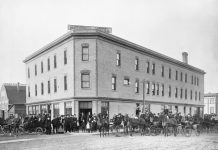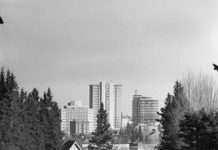The good news…
by Marilyn Williams
The CDEA, Conseil de Développement Économique de l’Alberta, the francophone economic development organization for southern Alberta, received funding from the provincial francophone secretariat for a Rouleauville District francophone project that includes a re-publication – this time bilingual – of the French walking tour produced in 2012. The project will also develop a podcast about heritage sites of interest and provide marketing and promotion of the area. The Cliff Bungalow – Mission Community Association is a partner in this project and will also contribute funding and volunteer time.
The project was one of thirteen recipients of the first intake of the Tourism Growth Innovation Fund (TGIF) intended to expand tourism in the winter and shoulder seasons in smaller diversity communities and niche markets. The Minister of Culture and Tourism, Ricardo Miranda, used Rouleauville Square as the platform to announce the recipients on September 4th and explained that the funds “will attract more people to Alberta and inspire them to explore off the beaten path to find our hidden gems.”
Étienne Alary, executive director, CDEA said “This initiative will be a way to invite all francophones and francophiles from here and abroad to come learn and discover the history of the pioneers of our city using modern technology.”
If you drop by the park you will notice the damaged mural section has now been repaired. The mural, which dates to the park’s establishment in the late 1980s, is the work of internationally renowned ceramic artist and sculptor, James Marshall, based out of the Historic Clay District National Historic Site in Medicine Hat.
Things are also happening just around the corner with Rouleau House. The contract for the exterior restoration and interior rehabilitation has now been awarded so work can begin. The work includes adaption as offices and an accessibility upgrade, and is expected to be completed in 2019.
…and the bad news
As you may know, we were part of a working team that put forward a submission to the Historic Sites and Monuments Board of Canada to nominate the settlement of Mission Rouleauville on the plains of Western Canada as an event of national significance in 2013. It took the board almost three years to come to an unfavourable decision, and another two years to communicate the bad news. Earlier this year we wrote a letter to the editor of the Globe and Mail, which they did not publish (although we have received some coverage by French and English CBC radio reporters) so we decided to publish the letter in the Mission Statement:
Dear Editor:
The Historic Sites and Monuments Board of Canada decided in its wisdom in December 2015 to deny that Rouleauville and the Mission district in Calgary, established in the 1870s, are of national significance. Indeed, their experts argue, the community and its history are at best of “local” significance. And they didn’t feel it necessary to share their decision with the community and nomination committee until February 2018, over two years later.
Did they know that the Mission district’s land and the future presence of the Catholic Church, hospitals and schools in Calgary, indeed in Southern Alberta, were secured by Father Lacombe – yes that Father Lacombe? Did they know that Calgary’s ultimate site and its social, health and educational infrastructure were influenced by the location of the Catholic mission? But then, perhaps Calgary is not nationally important – just a local phenomenon! Did they know that Charles-Borromée Rouleau, a leader in Calgary’s Rouleauville and Mission, was the architect of the Catholic separate school system in Western Canada, one of the West’s first magistrates, and one of the first judges of the Supreme Court of the North West Territories? Maybe, but these considerations were probably too “territorial” or too “provincial” for the Historic Sites and Monuments Board of Canada. Did they know that the roots of Calgary’s love of French immersion, the City with one of the strongest programmes in Canada, can trace its origins to Rouleau and the Mission? Perhaps they did but again, perhaps in their minds neither the West, its embrace of Francophone culture, nor the incredible role those in the Mission district played in shaping the bilingual roots of the pre-1905 West matter. After all, it happened in the West. Indeed, the district, its Cathedral being at the end of 1st St. SW and 18th Avenue in Calgary, helped shaped the urban layout of that City as well. But then, to many, Calgary is just the Stampede – just an oil town.
It will be difficult for the many real Francophone foundations of Western Canada to be appreciated if our own bilingual nation refuses to accept that Calgary’s francophone and Catholic community is more than of local historic value.









